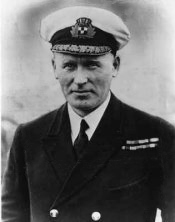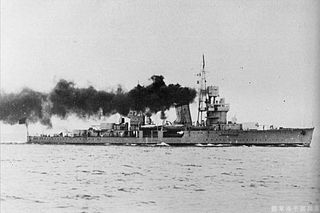
The Norfolk Naval Shipyard, often called the Norfolk Navy Yard and abbreviated as NNSY, is a U.S. Navy facility in Portsmouth, Virginia, for building, remodeling and repairing the Navy's ships. It is the oldest and largest industrial facility that belongs to the U.S. Navy as well as the most comprehensive. Located on the Elizabeth River, the yard is just a short distance upriver from its mouth at Hampton Roads.

USS Gilbert Islands (CVE-107) was a Commencement Bay-class escort carrier of the United States Navy.

USS Gettysburg (CG-64) is a Ticonderoga-class guided-missile cruiser in the United States Navy. She is named for the Battle of Gettysburg during the American Civil War.

The first USS Cassin (DD-43) was the lead ship of Cassin-class destroyers in the United States Navy during World War I. She was later transferred to the United States Coast Guard, where she was designated CG-1. She was named for Stephen Cassin.

John King was an Irish sailor in the United States Navy and one of only 19 in history to receive the Medal of Honor twice.

Ronald Niel Stuart, VC, DSO, RD, RNR was a British Merchant Navy commodore and Royal Navy captain who was highly commended following extensive and distinguished service at sea over a period of more than thirty-five years. During World War I he was awarded the Victoria Cross, the Distinguished Service Order, the French Croix de Guerre avec Palmes and the United States' Navy Cross for a series of daring operations he conducted while serving in the Royal Navy against the German U-boat campaign in the Atlantic.

USS Biscayne (AVP-11), later AGC-18, was a United States Navy Barnegat-class seaplane tender in commission as a seaplane tender from 1941 to 1943 and as an amphibious force flagship from 1943 to 1946. She saw service during World War II. Transferred to the United States Coast Guard after the war, she was in commission as the Coast Guard cutter USCGC Dexter (WAGC-385), later WAVP-385 and WHEC-385, from 1946 to 1952 and from 1958 to 1968.
Rescue and salvage ships are a type of military salvage tug. They are tasked with coming to the aid of stricken vessels. Their general mission capabilities include combat salvage, lifting, towing, retraction of grounded vessels, off-ship firefighting, and manned diving operations. They were common during World War II.

USS Chincoteague (AVP-24) was a United States Navy seaplane tender in commission from 1943 to 1946 that saw service in the Pacific during World War II. After the war, she was in commission in the United States Coast Guard as the cutter USCGC Chincoteague (WAVP-375), later WHEC-375, from 1949 to 1972. She was transferred to South Vietnam in 1972 and was commissioned into service with the Republic of Vietnam Navy as the frigate RVNS Lý Thường Kiệt (HQ-16), seeing combat in the Battle of the Paracel Islands in 1974. When South Vietnam collapsed at the conclusion of the Vietnam War in 1975, she fled to the Philippines, where she was commissioned into the Philippine Navy, serving as the frigate RPSAndrés Bonifacio (PF-7) from 1976 to 1985.
The Pusey and Jones Corporation was a major shipbuilder and industrial-equipment manufacturer. Based in Wilmington, Delaware, it operated from 1848 to 1959.

Note: This ship should not be confused with two other World War I-era ships named USS Mystery.

USS Arizonan (ID-4542A), also written ID-4542-A was a United States Navy cargo ship and troop transport in commission from 1918 to 1919.

USS Goliah (SP-1494), also listed as ID-1494, was an armed tug that served in the United States Navy as a patrol vessel and tug from 1918 to 1919.

Fighter Squadron 73 (VF-73), also known as the "Jesters", was a United States Navy fighter squadron established at Naval Air Station Quonset Point, Rhode Island on July 27, 1948, and disestablished on March 1, 1958.

Ping Hai was a light cruiser in the Chinese fleet before World War II and the second ship of the Ning Hai class. The ship was laid down in China to the specifications supplied by the Japanese, and Japanese advisors were hired to oversee the construction. Compared to its sister ship Ning Hai, it had a lower-output powerplant and lacked seaplane facilities. Its anti-aircraft armament was also different from that of its sister.

USS Yokes (APD-69), ex-DE-668, was a United States Navy high-speed transport in commission from 1944 to 1946.

USS Charles Mann (SP-522), was a United States Navy tug and patrol vessel in commission from 1917 to 1919.

USS Robert H. McCurdy was a United States Navy patrol vessel in commission from 1918 to 1919.

The Norinco Type 77 is a Chinese amphibious armoured personnel carrier. First fielded in 1978, it is similar to the Soviet BTR-50 in function. Like the BTR-50 designed by putting a higher hull on the PT-76 light tank chassis, Type 77 is based on the Type 63 light tank, which is itself a derivative of PT-76, making both vehicles very similar.


















